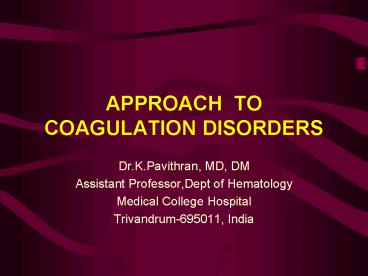APPROACH TO COAGULATION DISORDERS - PowerPoint PPT Presentation
1 / 20
Title:
APPROACH TO COAGULATION DISORDERS
Description:
6. Effect of stress, pregnancy, drugs. 7. Effect of PCV on the ... Kaolin clotting time. Dilute Russel's viper venom time. Platelet neutralization test ... – PowerPoint PPT presentation
Number of Views:526
Avg rating:3.0/5.0
Title: APPROACH TO COAGULATION DISORDERS
1
APPROACH TO COAGULATION DISORDERS
- Dr.K.Pavithran, MD, DM
- Assistant Professor,Dept of Hematology
- Medical College Hospital
- Trivandrum-695011, India
2
Clinical approach
- 1. Is the bleeding significant ?
- 2. Local Vs Systemic ?
- 3. Platelet Vs Coagulation disorder ?
- 4. Inherited Vs Acquired ?
3
Laboratory Approach
- 1. Demonstration of the defect
- 2. Identification of the defect(s)
- 3. Assessment of severity
- 4. Consequential studies eg. carrier detection
- 5. Monitoring of treatment
4
Screening Tests
- 1. Platelet count morphology
- 2. Bleeding Time
- 3. Clotting Time
- 4. Prothrombin Time
- 5. Activated Partial Thromboplastin Time
- 6. Thrombin Time
5
Collection of blood sample
- 1. Minimum circulatory stasis
- 2. Clean venous puncture
- 3. Proper anticoagulant
- 4. Proportion of blood to anticoagulant
- 5. Separation of plasma and storage
- 6. Effect of stress, pregnancy, drugs
- 7. Effect of PCV on the proportion of plasma
to anticoagulant
6
Prolonged PT/APTT
- Coagulation factor deficiency/inhibitor
- Test plus control plasma - 11
- Repeat PT/APTT
- gt 50 correction
- Yes - Factor deficiency
- No - inhibitor
timed incubation
abnormally increasing specific inhibitor
no change Lupus Anticoagulant
7
HMWK
VII
XII
PK
XI
APTT
PT
IX
VIII
X
PT - ? APTT, TT, PLC - N
V
TT
II
I
Factor VII deficiency Anticoagulant therapy
8
HMWK
VII
XII
PK
XI
APTT
PT
IX
VIII
X
APTT - ? PT, TT, PLC - N
V
TT
II
I
Factor deficiency vWD Inhibitors Heparin
therapy
9
Mixing tests with APTT
APTT of test plasma Aged plasma Adsorbed
plasma Diagnosis
No correction Corrected VIII Corrected No
correction IX Corrected Corrected XI,XII
10
Prolonged APTT, BT
von Willebrands disease
Ristocetin Induced Platelet Agglutination VIII
C vWFAg vWF multimeric analysis
Type 1 - Partial deficiency of vWF 2A
- Absence of large and interm. multimers
2B - Absence of large multimers 2M-
multimers normal, pl. function ? 2N - ?
affinity for FVIII 3 - severe
deficiency of vWF
11
HMWK
VII
XII
PK
XI
APTT
PT
IX
VIII
X
V
PT, APTT - ? TT, PLC - N
TT
II
I
Common Pathway Factor deficiency Vitamin
K deficiency Oral anticoagulant therapy
Liver disease
12
Mixing tests with PT
PT of test plasma Aged plasma adsorbed
plasma Diagnosis
Corrected Not corrected X Not
corrected Corrected V Not corrected
Partial II
13
HMWK
VII
XII
PK
XI
APTT
PT
IX
VIII
X
V
PT, APTT, TT - ? PLC - N
TT
II
I
Hypo / dysfibrinogenemia Heparin Liver
disease Systemic hyperfibrinolysis
14
HMWK
VII
XII
PK
XI
APTT
PT
IX
VIII
X
APTT, PT,TT all ? PLC - low
V
TT
II
I
DIC - FDP - D-dimer - Fibrin monomer
15
HMWK
VII
XII
PK
XI
APTT
PT
IX
VIII
X
PT, APTT- ? TT - N PLC - ?
V
TT
II
I
Massive transfusion with stored blood
16
HMWK
VII
XII
PK
XI
APTT
PT
IX
VIII
X
PT, APTT,TT-N PLC - ?
V
II
TT
I
Thrombocytopenia Pseudo vs True Bone
marrow biopsy to differentiate ? production
? destruction
17
PT, APTT, TT, PLC - Normal
- Factor XIII deficiency
- Thrombasthenia
- congenital
- drug induced
- Disorders of vascular hemostasis
- Factor XIII - clot solubility
- Platelet function
- BT
- clot retraction
- 1 minute platelet count
- aggregation
- Tourniquet test
18
Asymptomatic Patient
- Routine screening tests shows prolonged APTT
- Inhibitor - lupus anticoagulant
- Factor XII deficiency
- Mild congenital factor deficiency
19
Antiphospholipid Antibody SyndromeCriteria by
Branch and Silver 1996
- Clinical
- Recurrent abortion
- Recurrent venous thrombosis
- Recurrent arterial thrombosis
- Persistent thrombocytopenia
- Livedo reticularis
- Laboratory
- IgG/IgM anticardiolipin Ab
- Lupus anticoagulant
- Diagnosis
- 1 clinical 1 lab criteria
- Lab result must be positive on at least 2
occasions more than 3 months apart
20
Lupus Anticoagulant
- Kaolin clotting time
- Dilute Russels viper venom time
- Platelet neutralization test
- Tissue thromboplastin inhibition test

